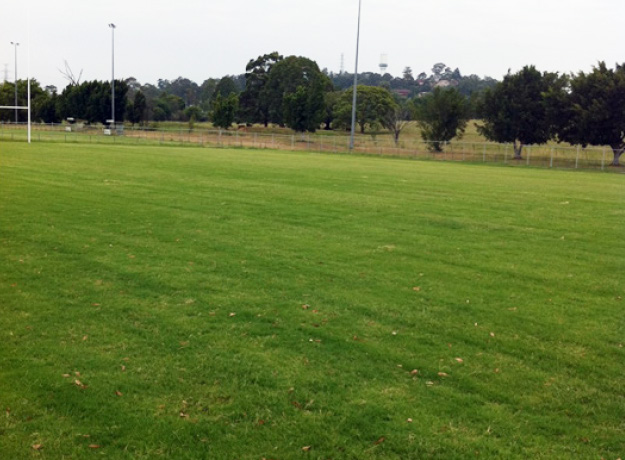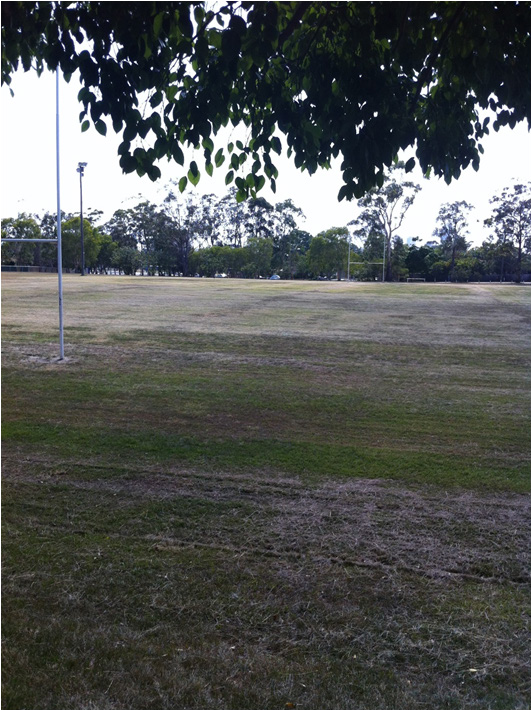Projects > Colleges Rugby Union
Hancey’s Turf was contracted to drainage and re-surfacing works for the Colleges Rugby Union Club and Griffith University at their campus ground on Benowa rd., at Ashmore. The club had contacted the Sports Turf Research Institute (STRI) to assess the condition of the playing field and recommend remedial works to improve the surface’s performance.
- Water-logging, leading to poor stability and loss of fixtures
- Compacted sub soil surface, meaning poor root growth minimizing turf health
- Uneven finish levels, leaving an inconsistent surface
- Poor grass coverage, weeds and weaker grasses outgrew desired variety
- Field being over used, exaggeration of all previous problems
The STI gave advice and recommendations to the Club on how to alleviate the problems. Poor drainage was found to be one of the key limitations in the ground’s performance. This problem stems from having a limited depth of compacted topsoil over an impermeable clay base. Hanceys Turf was selected as the preferred contractor to carry out the works having worked closely and successfully with the STI on several similar projects in recent years. The scope and order of works were to be completed as efficiently as possible due to a short time frame during the close season and minimal budget due to grant constraints.
The program of works was as follows
1. HERBICIDE TREATMENT
Liquid Glyphosate herbicide sprayed over the surface to kill off all existing grasses.
2. SCALP/DEEP SCARIFY
To remove all dead grasses and debris from the field.
3. DEEP RIP/CULTIVATION
The field was ripped to a depth of 300mm with solid tines, and then cultivated using a 2.2 metre wide rotary hoe to a depth of 200mm. This process ensured all compaction was relieved in the to 300mm of the sub-soil, removing trapped noxious gases, aiding the new turf to establish, promoting root growth, improving water movement and increasing root biomass thus fertilizer uptake by the new turf.
4. LAZER GRADE
After de-compaction the field levels need to be re-shaped prior to the drainage installation. It was decided that the standard crown shape be given to the field, with the centre spot being the highest point on the pitch with falls of 1.4% (or 1 in 70) in all directions from there.
5.1 INSTALL DRAINAGE SYSTEM
A grid drainage system was chosen by the STI as a means of removing surface water from the field after heavy downpours and wet weather. It is a commonly used system with proven success in many sports fields worldwide. Hancey’s Turf has constructed several drainage systems of this type, especially recently after wetter than usual summers. In the first instance, drainage installation focused on laying a framework of lateral, collector pipe drains that will ultimately serve as the outlet for a close-spaced, slit drainage system for optimal water clearance.
Issues to consider when installing a drainage system for existing sports grounds include:
- The presence of cabling for floodlighting, underground services such as existing irrigation, gas or mains town water.
- The need to consider future expansion of the drainage system so as to encompass the adjacent training areas.
- Account for possible re-alignment of the field, so that two fields could be installed and used North to South on the oval.
- The limited topsoil depth and compactive nature of the subsoil over the underlying clay base.
- The need to incorporate a new irrigation system in the profile.
It was also critical for the club, with a limited budget, to appreciate that the lateral pipe drainage system is primarily there to outlet water from a subsequently installed close-spaced slit drainage system. Thus, the effectiveness of the pipe drains acting on their own would be very limited. Once this was understood, then the club can move forward
in trying to acquire further grants so as to complete the drainage system in the near future and maximize the capital already invested.
5.1 KEY ELEMENTS IN DRAINAGE DESIGN AND INSTALLATION
Drainage outlets
The field drains had two outlets into an existing ring drain sump. In effect this meant that the sub-mains all ran in one direction, so it was imperative to get the falls correct when installing.
Contour plan
Due to the chosen shape of the field when grading, all lateral drains followed the falls on the field surface to ensure rapid water movement to each end from the field centre.
Sub main installation
Two sub main drains were installed at either end of the field, approximately 1m from the edge of field play, just inside an existing embankment. The sub-mains were installed to the following design specifications; – trench from 850mm depth through to 650mm a point of entry into the sump at a width of 200mm
- Trenches were lazer graded to ensure a consistent slope of 1 in 200
- The pipes, which were layed on the base of the trench, 160mm perforated corrugated plastic.
- Specialist junctions were used for connection into the sump and for junctioning with the 100mm laterals
- Small stone(5-7mm) was used to surround the pipes and brought to within 200mm of the surface, removed spoil was then used to backfill to the surface.
Lateral drains
Lateral drain lines were installed running the length of the field and connecting into the sub-mains at both ends. Lateral drainage criteria included:
- Spaced 14 meters apart, 7 drain lines in all
- Trenches excavated to a constant depth of 450mm, leaving 350mm from the top of the pipe to the surface
- Trench width was 150mm
- 100mm corrugated plastic pipe was layed on the base of the trench
- Fine stone(2-7mm) was used to back-fill to within 125mm of the surface
- A sandy loam was then used to top up drains to finish level and compacted in
We then stepped back for three days while the new irrigation system was put in by “all about pump” who sub contracted the installation. Once it was tested and all in good working order we began our final works.
6. FINAL TRIM AND LEVEL
Again using the lazer grader we levelled the surface. This practice also had the advantage of naturally compacting the drain lines so that future sinking was prevented.
7. SUPPLY AND SPREAD OF GYPSUM AND FERTILIZER
We applied Gypsum (calcium sulphate) to the surface for its beneficial characteristics. While Lime (calcium carbonate) is often used in agriculture as a soil enhancing substance, it can also dramatically raise the P.H which in our case would hinder good turf growth. Gypsum is a more naturally occurring mineral. It provides calcium and sulphur, both essential nutrients, but does not effect soil P.H. It is typically a neutral salt(p.h 6.7) and has a salt index, or osmotic potential, of 8. The sulphur is in a plant available, or sulphate form. In addition to providing needed nutrients, the calcium in gypsum is soluble, even at a P.H that is >7. Thus it is very helpful in improving soil tilth, reducing soil compaction and improving aeration. A general purpose fertilizer was also applied to aid rapid turf establishment.
8. SUPPLY AND INSTALL 7700 SQM TURF
We then supplied Wintergreen Couch grass in slab form to be laid on the field. This process took two days and came from the paddocks at our Woodford farm. Wintergreen couch is a tried and tested turf for sportsturf fields. It has the harder wearing, fast recovery characteristics required for high usage areas and well as being aesthetically pleasing all year round(as the name suggests). The turf laying process took 2 days to complete and then we gave a final roll to the turf to bed it in. Watering in using the new irrigation was barely needed as the rain came, for once at a convenient time.
9. TOP-DRESSING
Four weeks after the turf was laid, and after the field had been mowed twice, we top-dressed the field. I used 90% sand to 10% soil and peatmoss top-dressing blend, which is standard industry practice. The top-dressing is even out any imperfections in the turf and help the turf joins to knit together. The material is spread using a hopper then rubbed in with a drag mat. 100 cubic meters of material was used (or 135 tonne) which gave a 10mm layer over the surface.
GENERAL PRACTICE
As a general rule, work only took place when the field was in a dry state and a few weather delays were inevitable. However the whole process of renovation and drainage installation was completed in a three week period which was ahead of schedule and within budget. Colleges Rugby Club have gone from one of the worst fields in the league to one of the best and having gathered feedback from the club secretary and president, all players and officials are very happy with the new playing surface.
Mark Sanders – club president
Colleges Rugby Union Club
Keith McAuliffe
Sports Turf Institute
Mark Patterson
Hancey’s Turf





